Emerson 475 User Manual
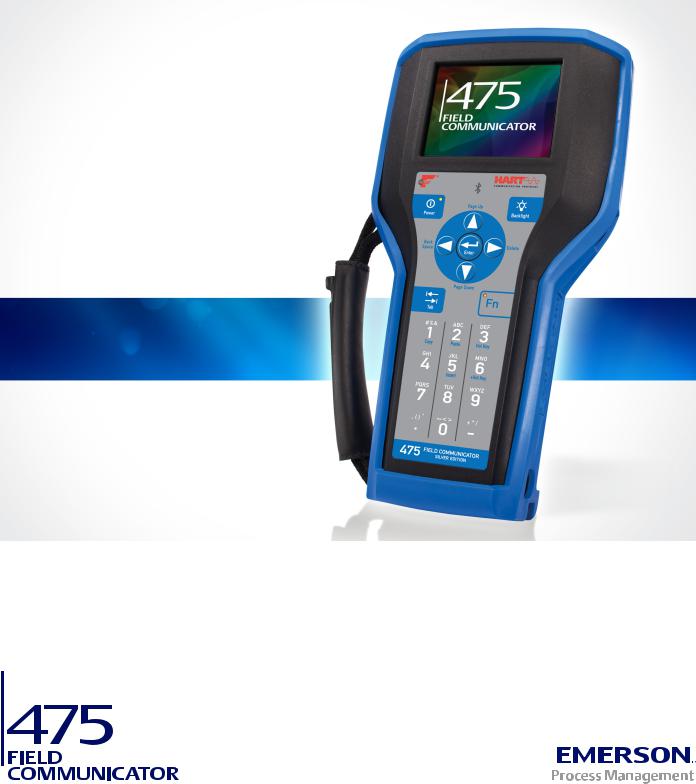
User’s Manual
Rev K
May 2015
475 Field Communicator
User’s Manual

475 FIELD COMMUNICATOR
475 Field Communicator
NOTICE
Read this User’s Manual before working with the 475 Field Communicator. For personal and system safety, and for optimum product performance, thoroughly understand the contents before using or servicing this product.
For equipment service needs, contact the nearest product representative.
©Emerson Process Management. 2015. All rights reserved.
The Emerson logo is a trademark and service mark of Emerson Electric Co.
AMS, DeltaV, and ValveLink are marks of one of the Emerson group of companies.
Windows is a registered trademark of Microsoft Corporation in the United States and other countries.
IrDA is a registered trademark of the Infrared Data Association. Bluetooth is a registered trademark of the Bluetooth SIG, Inc. FOUNDATION is a trademark of the Fieldbus Foundation of Austin, Texas, USA.
HART and WirelessHART are registered trademarks of the HART Communication Foundation of Austin, Texas, USA.
Hitachi is a registered trademark of Hitachi America, Ltd. All other marks are property of their respective owners.
www.fieldcommunicator.com

475 FIELD COMMUNICATOR
TABLE OF CONTENTS
SECTION 1
Introduction
Using this manual. . . . . . . . . . . . . . . . . . . . . . . . . . . . . . . . 7
SECTION 2 Learning the basics
Overview . . . . . . . . . . . . . . . . . . . . . . . . . . . . . . . . . . . . . . . 9 Safety messages . . . . . . . . . . . . . . . . . . . . . . . . . . . . . . . . 9 475 Field Communicator overview . . . . . . . . . . . . . . . . . 10
Device interoperability. . . . . . . . . . . . . . . . . . . . . . . . . . . 10 Working in a hazardous area . . . . . . . . . . . . . . . . . . . . . 11 Battery and
power supply/charger . . . . . . . . . . . . . . . . . . . . . . . . . . . 11 Using the touch screen . . . . . . . . . . . . . . . . . . . . . . . . . . 16 Using the keypad . . . . . . . . . . . . . . . . . . . . . . . . . . . . . . 16 Memory . . . . . . . . . . . . . . . . . . . . . . . . . . . . . . . . . . . . . . 18 Accessories. . . . . . . . . . . . . . . . . . . . . . . . . . . . . . . . . . . 19
Assembly. . . . . . . . . . . . . . . . . . . . . . . . . . . . . . . . . . . . . . 21
Installing the System Card and the battery . . . . . . . . . . . 21 Removing the battery and the System Card . . . . . . . . . . 22
Starting up and shutting down . . . . . . . . . . . . . . . . . . . . 22
Starting up. . . . . . . . . . . . . . . . . . . . . . . . . . . . . . . . . . . . 22 The Field Communicator Main Menu . . . . . . . . . . . . . . . 22 Entering standby . . . . . . . . . . . . . . . . . . . . . . . . . . . . . . . 23 Shutting down . . . . . . . . . . . . . . . . . . . . . . . . . . . . . . . . . 23
Settings . . . . . . . . . . . . . . . . . . . . . . . . . . . . . . . . . . . . . . . 24
About. . . . . . . . . . . . . . . . . . . . . . . . . . . . . . . . . . . . . . . . 24
Backlight . . . . . . . . . . . . . . . . . . . . . . . . . . . . . . . . . . . . . 24
Clock . . . . . . . . . . . . . . . . . . . . . . . . . . . . . . . . . . . . . . . . 24
Contrast . . . . . . . . . . . . . . . . . . . . . . . . . . . . . . . . . . . . . 25
Licenses . . . . . . . . . . . . . . . . . . . . . . . . . . . . . . . . . . . . . 25
Power . . . . . . . . . . . . . . . . . . . . . . . . . . . . . . . . . . . . . . . 25
Power Button . . . . . . . . . . . . . . . . . . . . . . . . . . . . . . . . . 26
Retrain Battery . . . . . . . . . . . . . . . . . . . . . . . . . . . . . . . . 26
Touch Screen . . . . . . . . . . . . . . . . . . . . . . . . . . . . . . . . . 26
Event Capture . . . . . . . . . . . . . . . . . . . . . . . . . . . . . . . . . 27
Memory . . . . . . . . . . . . . . . . . . . . . . . . . . . . . . . . . . . . . . 27
Connecting to a device . . . . . . . . . . . . . . . . . . . . . . . . . . 28 PC applications. . . . . . . . . . . . . . . . . . . . . . . . . . . . . . . . . 28
AMS Device Manager . . . . . . . . . . . . . . . . . . . . . . . . . . . 28
Field Communicator Easy Upgrade Utility . . . . . . . . . . . 28 Connecting the 475 Field Communicator or System Card29 Upgrading the 475 Field Communicator . . . . . . . . . . . . . 33
www.fieldcommunicator.com

4 |
Table of Contents |
Adding functionality by enabling licenses . . . . . . . . . . . . 33
ScratchPad . . . . . . . . . . . . . . . . . . . . . . . . . . . . . . . . . . . . 34
Creating a new document . . . . . . . . . . . . . . . . . . . . . . . . 35
Opening an existing document . . . . . . . . . . . . . . . . . . . . 35
ValveLink Mobile . . . . . . . . . . . . . . . . . . . . . . . . . . . . . . . 37
Maintenance . . . . . . . . . . . . . . . . . . . . . . . . . . . . . . . . . . . 37
Running a self test . . . . . . . . . . . . . . . . . . . . . . . . . . . . . 37
Calibrating. . . . . . . . . . . . . . . . . . . . . . . . . . . . . . . . . . . . 37
SECTION 3
HART functionality
Overview . . . . . . . . . . . . . . . . . . . . . . . . . . . . . . . . . . . . . . 39 Safety messages . . . . . . . . . . . . . . . . . . . . . . . . . . . . . . . 39 Basic features and functions . . . . . . . . . . . . . . . . . . . . . 40
HART Application functionality . . . . . . . . . . . . . . . . . . . . 40 Using a fast key sequence . . . . . . . . . . . . . . . . . . . . . . . 40
Starting the HART Application . . . . . . . . . . . . . . . . . . . . 40 Working with offline configurations . . . . . . . . . . . . . . . . 41
Creating a new configuration . . . . . . . . . . . . . . . . . . . . . 41 Opening a saved configuration . . . . . . . . . . . . . . . . . . . . 42 Transferring configurations to a PC application . . . . . . . 44
Working online with HART devices . . . . . . . . . . . . . . . . 45
Connecting to a HART device. . . . . . . . . . . . . . . . . . . . . 45 Displaying the connected HART devices . . . . . . . . . . . . 48 The HART icon . . . . . . . . . . . . . . . . . . . . . . . . . . . . . . . . 49 Saving a device configuration . . . . . . . . . . . . . . . . . . . . . 49 Displaying Device Setup options . . . . . . . . . . . . . . . . . . 50 Displaying Graphics . . . . . . . . . . . . . . . . . . . . . . . . . . . . 51
Configuring the HART Application . . . . . . . . . . . . . . . . . 52
Using hot keys . . . . . . . . . . . . . . . . . . . . . . . . . . . . . . . . 52 Changing the HART polling options . . . . . . . . . . . . . . . . 53 Ignoring status messages . . . . . . . . . . . . . . . . . . . . . . . . 55 Displaying the HART short tag or long tag in a menu title 55 Storage Cleanup . . . . . . . . . . . . . . . . . . . . . . . . . . . . . . . 55 Viewing available device descriptions. . . . . . . . . . . . . . . 56 Simulating an online connection to a HART device . . . . 56
Running HART diagnostics . . . . . . . . . . . . . . . . . . . . . . . 57
DC voltage measurement (HART terminals) . . . . . . . . . 57
Disconnecting from a HART device . . . . . . . . . . . . . . . . 57
SECTION 4
Fieldbus functionality
Overview . . . . . . . . . . . . . . . . . . . . . . . . . . . . . . . . . . . . . . 59 Safety messages . . . . . . . . . . . . . . . . . . . . . . . . . . . . . . . 59 Basic features and functions . . . . . . . . . . . . . . . . . . . . . 60
Fieldbus Application functionality . . . . . . . . . . . . . . . . . . 60 Link Active Scheduler (LAS) . . . . . . . . . . . . . . . . . . . . . . 60 LAS hierarchy . . . . . . . . . . . . . . . . . . . . . . . . . . . . . . . . . 60

Table of Contents |
5 |
Starting the Fieldbus Application . . . . . . . . . . . . . . . . . . 61
Working online with fieldbus devices . . . . . . . . . . . . . . 61
Connecting to a fieldbus device . . . . . . . . . . . . . . . . . . . 62
Displaying the connected fieldbus devices . . . . . . . . . . . 65
Displaying the online device . . . . . . . . . . . . . . . . . . . . . . 66
Block modes . . . . . . . . . . . . . . . . . . . . . . . . . . . . . . . . . . 66
Device blocks . . . . . . . . . . . . . . . . . . . . . . . . . . . . . . . . . 69
Displaying Graphics . . . . . . . . . . . . . . . . . . . . . . . . . . . . 75
Configuring the Fieldbus Application . . . . . . . . . . . . . . 75
Changing the fieldbus polling addresses . . . . . . . . . . . . 75
Changing the Slot Time . . . . . . . . . . . . . . . . . . . . . . . . . 76
Viewing available device descriptions. . . . . . . . . . . . . . . 76
Running fieldbus diagnostics . . . . . . . . . . . . . . . . . . . . . 77
DC voltage measurement . . . . . . . . . . . . . . . . . . . . . . . . 77
Noise level measurement . . . . . . . . . . . . . . . . . . . . . . . . 77
Signal level measurement. . . . . . . . . . . . . . . . . . . . . . . . 77
Disconnecting from a fieldbus device . . . . . . . . . . . . . . 78
SECTION 5 Troubleshooting
Overview . . . . . . . . . . . . . . . . . . . . . . . . . . . . . . . . . . . . . . 79
Troubleshooting suggestions . . . . . . . . . . . . . . . . . . . . . 79
Error and status messages . . . . . . . . . . . . . . . . . . . . . . . 84 Information for Technical Support . . . . . . . . . . . . . . . . . 90
APPENDIX A Reference data
Processor and memory specifications. . . . . . . . . . . . . . 91
Microprocessor . . . . . . . . . . . . . . . . . . . . . . . . . . . . . . . . 91
Memory . . . . . . . . . . . . . . . . . . . . . . . . . . . . . . . . . . . . . . 91
Physical specifications . . . . . . . . . . . . . . . . . . . . . . . . . . 91
Weight. . . . . . . . . . . . . . . . . . . . . . . . . . . . . . . . . . . . . . . 91
Display . . . . . . . . . . . . . . . . . . . . . . . . . . . . . . . . . . . . . . 91
Keypad . . . . . . . . . . . . . . . . . . . . . . . . . . . . . . . . . . . . . . 91
Usage specifications . . . . . . . . . . . . . . . . . . . . . . . . . . . . 92
Temperature limits . . . . . . . . . . . . . . . . . . . . . . . . . . . . . 92 Storage with batteries . . . . . . . . . . . . . . . . . . . . . . . . . . . 92 Storage without batteries . . . . . . . . . . . . . . . . . . . . . . . . 92 Enclosure rating . . . . . . . . . . . . . . . . . . . . . . . . . . . . . . . 92 Shock . . . . . . . . . . . . . . . . . . . . . . . . . . . . . . . . . . . . . . . 92 General guidelines . . . . . . . . . . . . . . . . . . . . . . . . . . . . . 92
Connection specifications. . . . . . . . . . . . . . . . . . . . . . . . 92
HART and fieldbus communication terminals . . . . . . . . . 92 Connection types . . . . . . . . . . . . . . . . . . . . . . . . . . . . . . 92
Battery specifications . . . . . . . . . . . . . . . . . . . . . . . . . . . 93
Battery type. . . . . . . . . . . . . . . . . . . . . . . . . . . . . . . . . . . 93 Connection . . . . . . . . . . . . . . . . . . . . . . . . . . . . . . . . . . . 93 Charge . . . . . . . . . . . . . . . . . . . . . . . . . . . . . . . . . . . . . . 93

6 |
Table of Contents |
Lights . . . . . . . . . . . . . . . . . . . . . . . . . . . . . . . . . . . . . . . 93
Operating time . . . . . . . . . . . . . . . . . . . . . . . . . . . . . . . . 93
Storage . . . . . . . . . . . . . . . . . . . . . . . . . . . . . . . . . . . . . . 93
Power supply/charger specifications . . . . . . . . . . . . . . . 94
Connection . . . . . . . . . . . . . . . . . . . . . . . . . . . . . . . . . . . 94
Lights . . . . . . . . . . . . . . . . . . . . . . . . . . . . . . . . . . . . . . . 94
Voltage . . . . . . . . . . . . . . . . . . . . . . . . . . . . . . . . . . . . . . 94
Technical data. . . . . . . . . . . . . . . . . . . . . . . . . . . . . . . . . 94
Order information . . . . . . . . . . . . . . . . . . . . . . . . . . . . . . . 95
Spare parts list . . . . . . . . . . . . . . . . . . . . . . . . . . . . . . . . . 97
APPENDIX B Product certifications
Overview . . . . . . . . . . . . . . . . . . . . . . . . . . . . . . . . . . . . . . 99
Approved Manufacturing Locations . . . . . . . . . . . . . . . . 99
FCC . . . . . . . . . . . . . . . . . . . . . . . . . . . . . . . . . . . . . . . . . . 99
IC . . . . . . . . . . . . . . . . . . . . . . . . . . . . . . . . . . . . . . . . . . . . 99
Telecommunications Regulatory Authority . . . . . . . . . 100
European Directive Information - CE Compliance . . . 100
R&TTE (1999/5/EC) . . . . . . . . . . . . . . . . . . . . . . . . . . . 100
Electro Magnetic Compatibility (2004/108/EC) . . . . . . . 100
Low Voltage (2006/95/EC) . . . . . . . . . . . . . . . . . . . . . . 100 ATEX Directive (94/9/EC) (KL option only) . . . . . . . . . . 100
Hazardous Locations Certifications (KL option only). 100
European Certifications. . . . . . . . . . . . . . . . . . . . . . . . . 100
International Certification . . . . . . . . . . . . . . . . . . . . . . . 101
North American Certifications . . . . . . . . . . . . . . . . . . . . 101
Power Supply/Charger Certification . . . . . . . . . . . . . . . 102
Declaration of Conformity/Approvals . . . . . . . . . . . . . . 102
Label Drawings. . . . . . . . . . . . . . . . . . . . . . . . . . . . . . . . 102
Approval Drawings. . . . . . . . . . . . . . . . . . . . . . . . . . . . . 106
APPENDIX C Graphics information
Overview . . . . . . . . . . . . . . . . . . . . . . . . . . . . . . . . . . . . . 111 Screen layout . . . . . . . . . . . . . . . . . . . . . . . . . . . . . . . . . 111 Buttons . . . . . . . . . . . . . . . . . . . . . . . . . . . . . . . . . . . . . . 112 Graphics options . . . . . . . . . . . . . . . . . . . . . . . . . . . . . . 112
Images . . . . . . . . . . . . . . . . . . . . . . . . . . . . . . . . . . . . . 112
Charts . . . . . . . . . . . . . . . . . . . . . . . . . . . . . . . . . . . . . . 113
Graphs . . . . . . . . . . . . . . . . . . . . . . . . . . . . . . . . . . . . . 116
Glossary . . . . . . . . . . . . . . . . . . . . . . . . . . . . . . . . . . . G-117
Index . . . . . . . . . . . . . . . . . . . . . . . . . . . . . . . . . . . I-125

|
475 FIELD COMMUNICATOR |
|
|
SECTION 1 |
INTRODUCTION |
USING THIS MANUAL |
The sections in this manual provide the following information on the |
|
475 Field Communicator. |
|
Section 2: Learning the basics contains information on assembly, |
|
components, starting, entering standby, shutting down, settings, |
|
supported PC applications, and maintaining the 475 Field |
|
Communicator. |
|
Section 3: HART functionality contains information on starting and |
|
configuring the HART® Application, working offline, communicating |
|
with HART devices, modifying device parameters, and running |
|
diagnostics. |
|
Section 4: Fieldbus functionality contains information on starting |
|
and configuring the Fieldbus Application, communicating with fieldbus |
|
devices, modifying device parameters, and running diagnostics. |
|
Section 5: Troubleshooting provides solutions to the most common |
|
475 Field Communicator operating problems. |
|
Appendix A: Reference data provides physical, functional, and |
|
performance specifications. |
|
Appendix B: Product certifications contains hazardous location |
|
and international certifications, European directive information, and |
|
approval drawings. |
|
Appendix C: Graphics information contains an overview of the |
|
Graphics functionality and options in the 475 Field Communicator. |
www.fieldcommunicator.com
8 |
Introduction |
|
|

|
|
475 FIELD COMMUNICATOR |
|
|
|
|
|
SECTION 2 |
LEARNING THE BASICS |
||
OVERVIEW |
This section provides instructions on basic features and functions of |
||
|
the 475 Field Communicator. It also provides information on assembly, |
||
|
components, starting, entering standby, shutting down, settings, |
||
|
applications, and maintaining the 475 Field Communicator. The |
||
|
functionality described in this section is based on system software |
||
|
version 3.9. |
||
SAFETY MESSAGES |
Procedures and instructions in this section may require special |
||
|
precautions to ensure the safety of the personnel performing the |
||
|
operation. Information that raises potential safety issues is indicated by |
||
|
a warning symbol ( ). Refer to the safety messages before |
||
|
performing an operation preceded by this symbol. See the |
||
|
“Troubleshooting” section for more warning messages. |
||
|
|
|
|
|
|
IMPORTANT NOTICE |
|
|
|
|
|
|
This equipment has been tested and found to comply with the |
|
|
|
limits for a Class A digital device, pursuant to part 15 of the FCC |
|
|
|
Rules. These limits are designed to provide reasonable protection |
|
|
|
against harmful interference when the equipment is operated in a |
|
|
|
commercial environment. This equipment generates, uses, and |
|
|
|
can radiate radio frequency energy and, if not installed and used in |
|
|
|
accordance with the user’s manual, may cause harmful |
|
|
|
interference to radio communications. Operation of this equipment |
|
|
|
in a residential area is likely to cause harmful interference in which |
|
|
|
case the user will be required to correct the interference at his own |
|
|
|
expense. |
|
|
|
This device complies with Part 15 of the FCC Rules. Operation is |
|
|
|
subject to the following two conditions: (1) this device may not |
|
|
|
cause harmful interference, and (2) this device must accept any |
|
|
|
interference received, including interference that may cause |
|
|
|
undesired operation. |
|
|
|
Any modifications made to this device that are not approved by |
|
|
|
Emerson Process Management may void the authority granted to |
|
|
|
the user by the FCC to operate this equipment. |
|
|
|
This Class A digital apparatus complies with Canadian ICES-003. |
|
|
www.fieldcommunicator.com

10 |
Learning the basics |
|
|
475 FIELD COMMUNICATOR OVERVIEW
Device interoperability


 WARNING
WARNING
You can install or remove the Lithium Ion (Li-Ion) battery (Power Module) in a hazardous area environment.You cannot charge the battery in this environment because the power supply/charger (00375-0003-0005) is not IS-approved.
The 475 Field Communicator supports HART and FOUNDATION fieldbus devices, letting you configure, maintain, or troubleshoot devices. When using the 475 Field Communicator to communicate with devices, follow all standards and procedures applicable to the location. Failure to comply may result in equipment damage and/or personal injury. Be sure to understand and comply with the sections in this manual.
The 475 Field Communicator includes a color LCD touch screen, a Li-Ion battery (Power Module), a SH3 processor, memory components, System Card, and integral communication and measurement circuitry.
The Field Communicator also supports multiple languages. See the readme file included with the Field Communicator Easy Upgrade Utility or www.fieldcommunicator.com for more information.
The 475 Field Communicator is designed to operate with a wide range of HART and FOUNDATION fieldbus devices independent of device manufacturer. Device interoperability is achieved through the Electronic Device Description Language (EDDL) technology supported by the HART Communication Foundation and Fieldbus Foundation.
Basic testing is performed on all device descriptions. Each device manufacturer is asked to certify that they thoroughly tested their devices with the 475 Field Communicator. If certification is not received, a warning message displays when you attempt to communicate with an untested device. New device descriptions are available from the Field Communicator Easy Upgrade Utility or the Resource CD or DVD.

Learning the basics |
11 |
|
|
Working in a hazardous area
Battery and
power supply/charger
A 475 Field Communicator that meets the Intrinsic Safety requirements (I/S-approved) can be used in Zone 0 (FM), Zone 1, or Zone 2, for Group IIC, and Class I, Division 1 and Division 2, Groups A, B, C, and D locations.
An IS-approved 475 Field Communicator may be connected to loops or segments that are attached to equipment located in Zone 0, Zone 1, Zone 2, for Group IIC; Zone 20, Zone 21, Zone 22, and Class I, Division 1 and Division 2, Groups A, B, C, and D locations.
IS-approved 475 Field Communicators are ordered with the KL option and have an additional label on the back of the 475 that lists the approvals.
See Appendix B “Product certifications” for more information about IS approvals and installations.
 CAUTION
CAUTION
You can install or remove the Li-Ion battery in a hazardous area environment. You cannot charge the battery in this environment because the power supply/charger is not IS-approved.
The 475 Field Communicator is powered by a Li-Ion battery that has a green, 6-pin connector. The power supply/charger also has a green connector to match the appropriate connector on the battery. See Figure 2-1 for the location of the connector.
Prior to using the 475 Field Communicator without the power supply/charger connected, fully charge the battery.
Guidelines and precautions
Understand and follow the guidelines and precautions below before using the battery or power supply/charger.
•When transporting a Li-Ion battery, follow all applicable regulations.
•Protect the battery and power supply/charger from moisture, and respect operating and storage temperature limits. See Appendix A “Reference data” for more information.
•Do not cover the battery or power supply/charger, subject it to prolonged periods of direct sunlight, or place it upon or next to heat-sensitive materials.
•Charge the battery with only the Field Communicator power supply/charger. The power supply/charger should not be used with other products. Failure to comply may permanently damage your 475 Field Communicator and will void the IS approval and the warranty.
•Do not open or modify the battery or power supply/charger. There are no user-serviceable components or safety elements inside. Opening or modifying them will void the warranty and could cause personal harm.
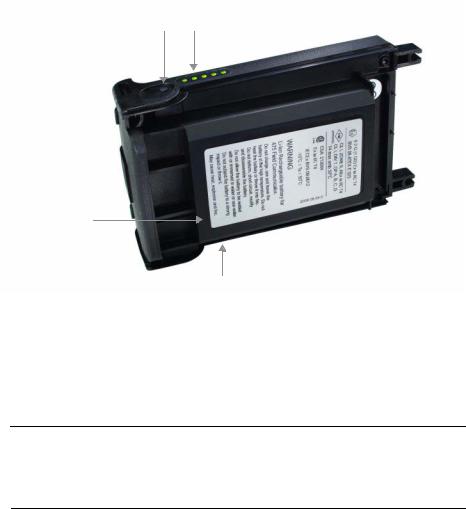
12 |
Learning the basics |
|
|
Checking the remaining charge
To view the remaining charge, press the Charge Indicator button on the lower left side of the battery. See Figure 2-1 for the location of this button. When you press and release the button, the lights above the button slowly illuminate to display the charge remaining. Each light represents 20 percent of the charge. The battery is fully charged when all of the lights are illuminated.
You can also check the remaining charge from the Settings menu on the Field Communicator Main Menu. See “Power” on page 25 for more information.
Figure 2-1. Li-Ion battery example
Charge Indicator button |
Lights illuminated by pressing the Charge |
Indicator button |
Li-Ion battery
Green power supply/charger connector (side)
Charging the battery
Prior to first portable use, fully charge the battery. The battery can be charged separately or while attached to the 475 Field Communicator. The 475 Field Communicator is fully operable while the battery is recharging, and a full charge takes 2-3 hours. An overcharge condition will not occur if the power supply/charger remains connected.
 CAUTION
CAUTION
You can remove and install the Li-Ion battery in a hazardous area environment. You cannot charge the battery in this environment because the power supply/charger is not IS-approved.
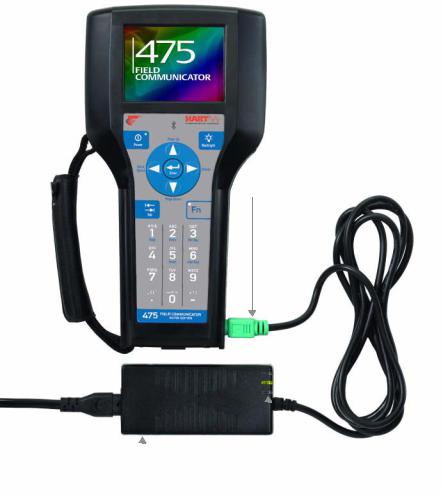
Learning the basics |
13 |
|
|
To charge the battery:
1.Plug the power supply/charger into a power outlet.
2.Plug the green power supply/charger connector into the green connector on the battery. The flat side of the power supply/charger connector should face the front of the 475 or the inside of the battery, if the battery is not attached to the 475. The battery is fully charged when the light on the power supply/charger is green.
Figure 2-2. Charging the battery connected to the 475 Field
Communicator
Power supply/charger connector
|
|
|
|
|
|
|
|
Power supply/charger |
Power supply/charger lights |
||
14 |
Learning the basics |
|
|
Power supply/charger lights
Three lights are on the power supply/charger to indicate the conditions below. Each light displays a different color.
Table 2-1. Power supply/charger lights
Color |
Condition |
Green |
The battery is fully charged. |
Flashing green |
The battery is nearly fully charged. |
Yellow |
The battery is charging. |
Flashing yellow |
The power supply/charger is not connected to |
|
the 475 Field Communicator. |
Flashing yellow and |
The remaining charge in the battery is very low. |
red |
|
Red |
Charging cannot occur. Contact Technical |
|
Support for more information. |
Maintaining the battery
To help maintain the performance and life of the Li-Ion battery, understand and follow the guidelines below:
•Recharge the battery frequently, preferably after each use or at night. Limit the number of full discharges, if possible.
•Frequent use at high temperatures can reduce performance.
•Use a dry location at or near room temperature when storing the battery for an extended time. Prolonged storage at higher temperatures can reduce performance.
•Ensure the remaining charge level is at or near mid-capacity when storing for an extended time. The remaining charge will slowly drain during storage. Periodically charge the battery to ensure the remaining charge does not drain to low levels.
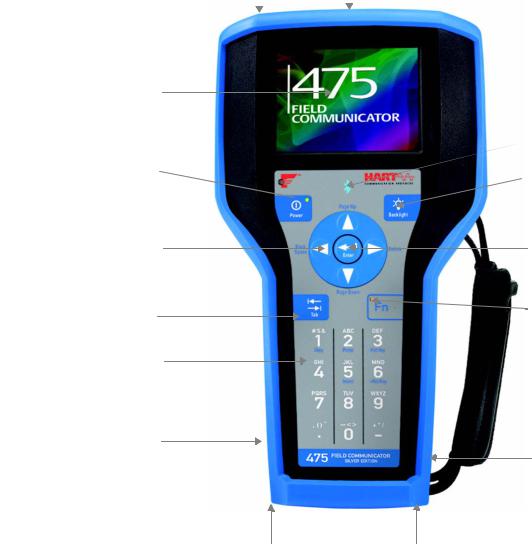
Learning the basics |
15 |
|
|
Figure 2-3. 475 Field Communicator shown with optional rubber boot
IrDA® interface |
HART and FOUNDATION fieldbus |
||
(top) |
communication terminals (top) |
||
|
|
||
|
|
|
|
|
|
|
|
Touch screen display
Power key and light
Strap attachment
 (side)
(side)
Navigation keys (four arrow keys)
Li-Ion battery (back) and
System Card (internal)
Tab key
Alphanumeric
keypad
Lights illuminated by pressing the Charge Indicator button (side)
Charge Indicator button  (side)
(side)
Strap attachment (side)
Bluetooth®
 light
light
 Backlight key
Backlight key
 Strap attachment (side)
Strap attachment (side)
Enter key
 Stylus (in the strap)
Stylus (in the strap)
 Function key and light (for multiple-key combination functionality)
Function key and light (for multiple-key combination functionality)
Green power supply/charger connector on the battery
(side)
Strap attachment (side)
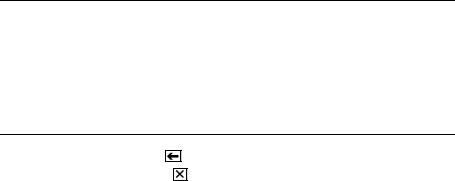
16 |
Learning the basics |
|
|
Using the touch screen The touch screen and keypad let you select menu items and enter text. Use the provided stylus or the up and down arrow keys on the keypad to select a menu item. On the Settings and Field Communicator Main Menu, tap an icon or press Enter to open the selected icon. On other menus, double-tap the selected item on the screen or press the right arrow key on the keypad to open a menu item.
CAUTION
Contact the touch screen with blunt items only, preferably the stylus included with the 475 Field Communicator. See Figure 2-3 on page 15 for the location of the stylus. Sharp instruments, such as screwdrivers, can damage the touch screen. Repairing the touch screen requires replacement of the entire display assembly, which is possible only at an authorized service center.
|
Use the back arrow icon ( |
) on the window to return to the previous |
|
menu. Use the close icon ( |
) in the upper right corner of the window |
|
to end the application. |
|
|
If the touch screen seems inaccurate, you can recalibrate it. For more |
|
|
information, see “Touch Screen” on page 26. |
|
|
|
|
|
NOTE |
|
|
All instructions in this manual are written for the touch screen. |
|
|
|
|
|
Use the soft input panel (SIP) keyboard |
|
|
The SIP keyboard allows for alphanumeric input using the touch |
|
|
screen. The SIP keyboard detects when you need to enter characters |
|
|
and appears automatically as required. |
|
Using the keypad |
The following section describes the buttons on the 475 Field |
|
|
Communicator keypad. |
|
Bluetooth symbol (  )
)
The Bluetooth symbol on the keypad is illuminated by a blue light when
Bluetooth is enabled from the Listen for PC window. The 475 Field
Communicator must be licensed for Bluetooth to use this functionality.
Power key
The Power key is used to power on and off the 475 Field Communicator or to put it in standby. You can set the default option, stand by or shut down, from the Settings menu. See “Power Button” on page 26 for more information. The green light on the Power key flashes when you press and hold the Power key to turn on the 475 Field Communicator. The light is constant when the 475 is on, and it slowly blinks when the 475 is in standby.
Learning the basics |
17 |
|
|
If the Power key is pressed when there is unsent data or a device method is running, a warning message appears. Tap OK to have the 475 Field Communicator enter standby or shut down, or tap Cancel to return to the previous window.
The Power key is disabled when the 475 Field Communicator is in Listen for PC mode or when the ScratchPad application is open.
Arrow navigation keys
Four arrow navigation keys let you move through the menus and icons in the applications. Press the up and down arrow keys to select a menu item. On the Settings and Field Communicator Main Menu, tap an icon or press the Enter key to open the selected menu. On all other menus, use the right arrow key to open a menu item or the left arrow key to return to the previous menu.
The blue text near the keys indicates alternate functionality that can be enabled by pressing the Function key.
Enter key
The Enter key lets you open the selected (highlighted) button on a window or an icon on the Field Communicator Main Menu or Settings Menu. For example, if you push the Enter key when the Cancel button on a window is selected, you will close that window.
Tab key
The Tab key lets you move between selectable controls on a window. Pressing the Tab key selects the icons from left to right across all of the rows on the screen.
Alphanumeric keypad
The alphanumeric keypad lets you enter letters, digits, and other characters, such as punctuation marks. The 475 Field Communicator automatically determines which text options are available depending upon the input necessary for the particular field.
To enter text when in alphanumeric mode, press the desired keypad button in quick repetition to scroll through the options to display the appropriate letter or number. For example, to type the letter Z, press the 9 key quickly four times.
The blue text near the keys indicates alternate functionality that can be enabled by pressing the Function key. The alternate function on the alphanumeric 5 key (insert) will be activated in future releases of the 475 Field Communicator software.
18 |
Learning the basics |
|
|
|
Backlight key |
|
The Backlight key lets you adjust the intensity of the touch screen |
|
display. There are four different settings. The intensity impacts the |
|
charge in the battery. Expect a shorter charge life for higher intensities. |
|
See “Backlight” on page 24 for information on timers that can turn off |
|
the backlight after specified periods of inactivity. These timers can help |
|
conserve the battery power. |
|
Function (Fn) key |
|
The Function key lets you enable alternate functionality on select keys. |
|
The Function key does not apply for menus displaying icons.The blue |
|
text near the other keys on the keypad indicate the alternate |
|
functionality. When the Function key is enabled, the orange light in the |
|
left corner of the Function key appears and the FN button on the Soft |
|
Input Panel (SIP), if displayed, is highlighted. Press the Function key |
|
again to disable the functionality and turn off the light. |
Memory |
Types |
|
The 475 Field Communicator memory consists of three components: |
|
1.Internal Flash—32MB non-volatile RAM. The Internal Flash memory |
|
stores the operating system and system software. It also stores the |
|
following: |
|
• Up to 25 HART configurations |
|
• HART Event Captures |
|
• FOUNDATION fieldbus statistics |
|
• Text files saved from ScratchPad |
|
2.System Card—an internal 1 GB or higher Secure Digital Card with |
|
non-volatile flash memory. A copy of installable system software |
|
exists on every System Card. The System Card also contains all |
|
HART and FOUNDATION fieldbus device descriptions and can store |
|
up to 1,000 HART configurations, depending on the sizes of the files. |
|
3.RAM—32MB used only for program execution. |
|
Available memory space |
|
To view the available memory in your 475 Field Communicator, |
|
connect to the Field Communicator Easy Upgrade Utility or tap the |
|
Memory icon from the Settings menu. The Field Communicator Main |
|
Menu displays the Settings menu item. See “Memory” on page 27 for |
|
more information. |
|
Free memory on the System Card |
|
Over time, your System Card may become full and unable to store new |
|
files. To free memory on your System Card, use the Memory |
|
Management feature in the Field Communicator Easy Upgrade Utility. |
|
This lets you filter and select which device descriptions can be |
|
transferred onto your System Card. Device descriptions from selected |
|
manufacturers or protocols are omitted during an upgrade, allowing |
|
more space for other files. |
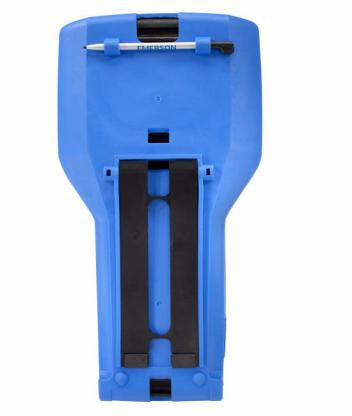
Learning the basics |
19 |
|
|
|
If the selected device descriptions are already on your 475, they are |
|
removed the next time you connect the 475 Field Communicator to the |
|
Easy Upgrade Utility. You are prompted before the files are removed. |
|
See the Easy Upgrade Utility Help for more information. |
Accessories |
Rubber boot |
|
A rubber boot can be purchased to further protect your 475 Field |
|
Communicator. The boot has an additional stand on the back, cut outs |
|
for the straps, and holders for the stylus. An anti-static material is used |
|
to meet the applicable Intrinsic Safety requirements. |
|
Figure 2-4. Back of the 475 Field Communicator Rubber Boot |
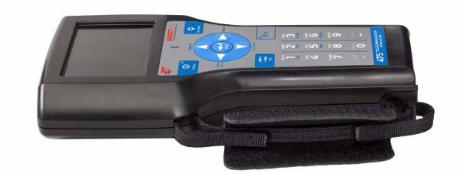
20 |
Learning the basics |
|
|
Straps
Two straps are available with the 475 Field Communicator. The magnetic strap attaches to the top of the 475 Field Communicator and lets you hang it from a metal pipe. The strap attachment is located near the HART and fieldbus terminals on the top of the 475 Field Communicator.
The side strap lets you attach a strap to the sides or back of the 475 Field Communicator, making it easy to carry. See Figure 2-5. The side strap also holds the stylus used with the touch screen.
Figure 2-5. Side Strap Example
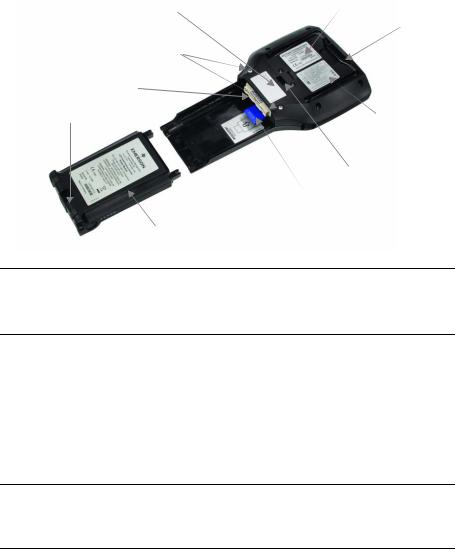
Learning the basics |
21 |
|
|
ASSEMBLY
Installing the System Card and the battery
If you received a 475 Field Communicator with the System Card already installed, proceed to the " Starting up" section.
1.Place the 475 Field Communicator face down on a level, secure surface.
2.Remove the protective rubber boot, if attached.
3.With the battery removed, slide the System Card (labeled System Card), with the metal card contacts facing up, into the System Card socket until it clicks. The System Card socket is spring-loaded. See Figure 2-6 for the location of the System Card socket.
The System Card is not locked into the System Card socket in the image below.
Figure 2-6. Back of the 475 Field Communicator
Bluetooth approval label
Battery retaining screws
Connector pins
Strap attachment
 Li-Ion battery
Li-Ion battery
Main unit label
 Stand
Stand
 IS label (KL option)
IS label (KL option)
Strap attachment
 System Card partially inserted into the System Card socket
System Card partially inserted into the System Card socket
CAUTION
The System Card must be supplied by the 475 Field Communicator manufacturer. Failure to comply will void the IS approval.
4.With the 475 Field Communicator still face down, ensure the tops of the two battery retaining screws are loose and slightly above the top of the 475.
5.Align the sides of the battery with the 475 and carefully slide it forward until it is secure.
6.Carefully hand tighten the two battery retaining screws to secure the battery. (Do not over tighten, 0.5Nm maximum torque load.)
CAUTION
The connector pins may be damaged if the 475 Field Communicator and battery are improperly aligned.
22 |
Learning the basics |
|
|
Removing the battery and the System Card
STARTING UP AND
SHUTTING DOWN
Starting up
The Field Communicator
Main Menu
To remove the battery and System Card:
1.Remove the rubber boot, if attached.
2.Place the 475 Field Communicator face down on a level, secure surface.
3.Loosen the battery retaining screws until the top of each screw is slightly above the top of the 475 Field Communicator.
4.Slide the battery off the 475 Field Communicator. Do not pull up the battery because this could damage the connector pins.
5.Push the System Card into the System Card socket until it clicks to release it. The System Card socket is spring-loaded.
6.Grasp the System Card with your fingers and slide it straight out of the 475 Field Communicator.
Prior to using the 475 Field Communicator without the power supply/charger, fully charge the battery. See “Charging the battery” on page 12 for more information.
Before operating the 475 Field Communicator, ensure:
•The 475 Field Communicator is not damaged.
•The battery is fully seated.
•All screws are sufficiently tightened.
•The communication terminal recess is free of dirt and debris.
Press and hold the Power key on the keypad until the green light on that key flashes (approximately two seconds). See Figure 2-3 on page 15 for the location of the Power key.
During startup, the 475 Field Communicator automatically checks for any system software upgrades available on the internal System Card. You are notified if an upgrade is on the System Card and ready to be installed. The Field Communicator Main Menu appears.
The Field Communicator Main Menu is the first menu that appears after you start the 475 Field Communicator. This menu lets you run the HART and the Fieldbus Applications, view the Settings menu, communicate with a PC, and launch ScratchPad or ValveLink™ Mobile. See Section 3 “HART Functionality” and Section 4 “Fieldbus Functionality” for more information on these applications.
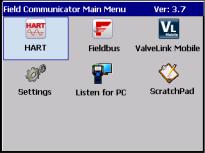
Learning the basics |
23 |
|
|
Figure 2-7. Field Communicator Main Menu
Entering standby |
You can put the 475 Field Communicator into standby to save power or |
|
to reduce the boot-up time if you are using the 475 Field |
|
Communicator intermittently. Standby turns off the touch screen and |
|
areas within the 475 Field Communicator. |
|
You can put the 475 Field Communicator in standby when the HART |
|
Application or the Fieldbus Application is running. If you are working |
|
online with a device when standby is entered, the application main |
|
menu is displayed when the 475 Field Communicator returns from |
|
standby. Otherwise, the 475 Field Communicator displays the last |
|
open window. |
|
To enter standby, press the Power key. From the Power Switch dialog |
|
box, tap Stand by and tap OK or press the Enter key. Tap Cancel to |
|
close the dialog box and return to the application. You can set the |
|
default option on the Power Switch dialog box. See “Power Button” on |
|
page 26 for more information.The green light on the Power key slowly |
|
flashes when the 475 Field Communicator is in standby. To leave |
|
standby, press the Power key. |
|
The 475 Field Communicator also enters standby if the standby timer |
|
has expired. See “Power” on page 25 for more information. |
Shutting down |
To shut down the 475 Field Communicator, press the Power key. From |
|
the Power Switch dialog box, tap Shut down and tap OK or press the |
|
Enter key. Tap Cancel to close the dialog box and return to the |
|
application. You can set the default option on the Power Switch dialog |
|
box. See “Power Button” on page 26 for more information. |
|
The 475 Field Communicator shuts down if the auto-off timer has |
|
expired. See “Power” on page 25 for more information. |
|
You can also shut down the 475 Field Communicator by |
|
simultaneously pressing the Backlight key and the Function key until |
|
the display turns off. The shut down is accomplished in the hardware |
|
(similar to removing the power to a PC using a switch). This is not the |
|
recommended way of shutting off the 475 Field Communicator. Use |
|
this method to shut down and reset the 475 Field Communicator if the |
|
screen appears to lock up and does not respond when you use the |
|
touch screen or keypad. |

24 |
Learning the basics |
|
|
SETTINGS |
You can view and modify the options below for the 475 Field |
|
Communicator from the Settings option on the Field Communicator |
|
Main Menu. |
|
To return to the Field Communicator Main Menu, tap the Back button |
|
on the screen. Tap the MORE button to view additional items on the |
|
Settings menu. |
About |
The About setting lets you view the software revisions in your 475 Field |
Communicator. If you need to call Technical Support personnel, have |
|
|
the system software version, Communication and Diagnostic Circuitry |
|
(CDC) version, and the operating system version available. |
|
Tapping RE-IMAGE re-installs the operating system, system software, |
|
and applications on your 475 Field Communicator. The power |
|
supply/charger must be connected when the RE-IMAGE operation is |
|
performed. During the operation, the standby and auto-off timers are |
|
disabled. This operation should only be performed under the direction |
|
of Technical Support personnel. |
|
Tapping RE-FLASH re-installs the firmware and software from the |
|
System Card. The power supply/charger must be connected when the |
|
RE-FLASH operation is performed. During the operation, the standby |
|
and auto-off timers are disabled. This operation should only be |
|
performed under the direction of Technical Support personnel. |
|
Tap OK to return to the Settings menu. |
Backlight |
The Backlight setting lets you adjust the backlight intensity of the |
screen. To adjust the backlight, drag the slider left to right. |
|
|
The Backlight setting also lets you set timers to automatically turn off |
|
the backlight after a specified period of inactivity to save battery power. |
|
To enable a timer, tap a drop-down list and select the appropriate time |
|
interval. The external power timer applies when the power |
|
supply/charger is connected to the 475 Field Communicator |
|
After you select the appropriate backlight settings, tap OK to retain this |
|
setting for this session only, SET DEFAULT to retain this setting upon |
|
startup, or CANCEL to exit without changes. |
Clock |
The Clock setting lets you set the date, time, and time zone on the 475 |
Field Communicator. Configure the date by using the drop-down list. |
|
|
To configure the time, select the appropriate time field and use the |
|
arrows to scroll through values until you find the correct time. Select |
|
the drop-down list to select a time zone. Tap OK to save the changes |
|
and to close the window, or CANCEL to exit without changes. |
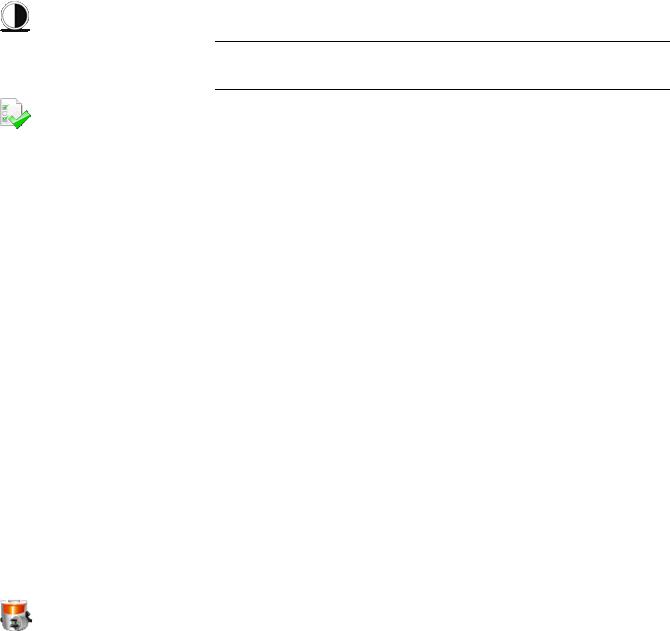
Learning the basics |
25 |
|
|
Contrast
Licenses
Power
The Contrast setting lets you adjust the lightest and darkest areas on the window. This option applies to only the 375 Field Communicator.
NOTE
Temperature can affect contrast.
The Licenses setting lets you view the enabled and available licenses for the 475 Field Communicator. A checkmark indicates the license is enabled. Unlicensed features cannot be accessed. The following licenses and information are displayed:
•HART - enables your 475 to run the HART Application to communicate with HART devices.
•Graphics - enables your 475 Field Communicator to display device information as images, charts, and graphs.
•Easy Upgrade - enables you to upgrade your 475 Field Communicator with the latest system software and device descriptions at your site, without having to send it to a service center.
•Exp Date - displays the expiration date of the Easy Upgrade license. The date is listed as year-month-day. N/A appears if the 475 is not licensed for Easy Upgrade.
•Bluetooth - enables your 475 Field Communicator to communicate with supported PC applications, such as the Easy Upgrade Utility, using Bluetooth.
•FOUNDATION fieldbus - enables the 475 Field Communicator to run the Fieldbus Application to communicate with fieldbus devices.
•Device Config Management - enables you to save HART device or user configurations to the System Card and to print and store them using the Easy Upgrade Utility.
The License window also displays the Unit Name and System Card Serial Number (SN) of the 475 Field Communicator. See the Easy Upgrade Utility Help for more details on assigning a Unit Name. Tap OK to return to the Settings menu.
The Power setting lets you specify power management options when the 475 Field Communicator is on battery power. The standby timer puts the 475 Field Communicator in standby and the auto-off timer shuts down the 475 Field Communicator after the specified values of inactivity. To specify values for the standby or auto-off timer, select the time intervals from the drop-down lists. If set to short intervals, these timers will save battery power.
The Maximize Power Savings option conserves additional battery power by letting the 475 Field Communicator enter standby or shut down when communicating with a device. To enable Maximize Power Savings, tap the checkbox. If this option is disabled, the 475 Field Communicator will not enter standby or shut down when communicating with a device.

26 |
Learning the basics |
|
|
After you select the appropriate power management settings, tap OK to apply the settings for this session only, SET DEFAULT to retain the settings upon startup, or CANCEL to exit without changes.
 The Power Button setting lets you set the default option for the Power Power Button Switch dialog. The Power Switch dialog appears when you press the
The Power Button setting lets you set the default option for the Power Power Button Switch dialog. The Power Switch dialog appears when you press the
Power key. This option does not let the Field Communicator automatically shut down or enter stand by when you press the Power key. You still need to tap OK.
From the Power Button screen, select the Stand by or Shut down option and then tap OK to apply the settings for this session only, SET DEFAULT to retain the settings upon startup, or CANCEL to exit without changes.
 The Retrain Battery setting lets you fully discharge the battery so it can Retrain Battery be charged to its full capacity. Perform this operation if you notice a
The Retrain Battery setting lets you fully discharge the battery so it can Retrain Battery be charged to its full capacity. Perform this operation if you notice a
significant decrease in charge life or performance.
CAUTION
It should not be necessary to perform this operation on a regular basis.
Doing so may damage the Li-Ion battery.
Ensure the power supply/charger is not connected when this operation is performed. During the operation, the backlight is set to its brightest setting to quickly discharge the battery. The backlight, standby, and auto-off timers are disabled. If you tap CANCEL, the battery stops discharging and the backlight, standby, and auto-off timers are re-enabled. The backlight setting is also restored.
After the battery is fully discharged, make sure it is fully recharged before using it without the power supply/charger. You can use the 475 Field Communicator while the battery is recharging.
To retrain the battery:
1.Disconnect the power supply/charger, if it is connected to the 475 Field Communicator.
2.Tap Retrain Battery from the Settings menu.
3.Wait until the 475 Field Communicator shuts down. It may take up to several hours to discharge the battery, depending on the charge remaining when the operation began.
Connect the power supply/charger to the 475 Field Communicator and fully charge the battery.
 The Touch Screen setting lets you calibrate the touch screen with the Touch Screen display. Tap the center of the cross hairs firmly and accurately at each
The Touch Screen setting lets you calibrate the touch screen with the Touch Screen display. Tap the center of the cross hairs firmly and accurately at each
location on the window. The target continues to move until the touch screen is aligned. Touch screen alignment is retained upon start up.
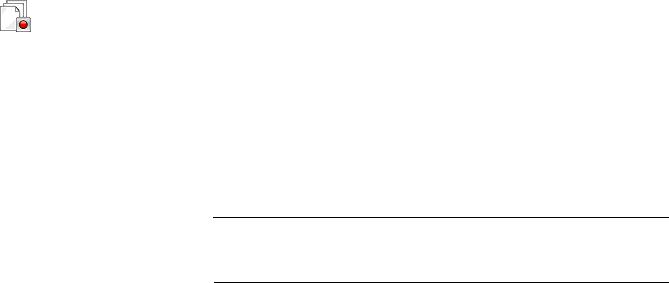
Learning the basics |
27 |
|
|
The Event Capture setting lets you create an Event Capture file (.rec), Event Capture which is a log of communication, input, and output that occurs between the 475 Field Communicator and a device (HART only). When working
with Technical Support personnel, you may be asked to create an Event Capture file to help troubleshoot issues that cannot be easily isolated or resolved. The Event Capture file can then be transferred to your PC using the Field Communicator Easy Upgrade Utility and sent to Technical Support personnel for review.
Tap the option to activate the Event Capture feature. The option is black when selected. To delete an existing Event Capture, tap
DELETE EVENT FILE.
NOTE
While Event Capture is enabled, device status and warning messages do not appear.
To create and send an Event Capture file:
1.Tap Settings from the Field Communicator Main Menu.
2.Tap MORE and then tap Event Capture.
3.Tap Turn on HART event capture from the Event Capture window and tap OK.
4.Tap HART from the Field Communicator Main Menu.
5.Enter a file name for the Event Capture file and tap OK. The file is saved to a default location.
6.Perform the requested operations to capture the data.
7.Use the Field Communicator Easy Upgrade Utility to transfer the file from your 475 Field Communicator to your PC. See the Easy Upgrade Utility Help for more information.
 The Memory setting lets you view available free space in the System Memory Card, Internal Flash, or RAM. To select the Memory icon, tap MORE
The Memory setting lets you view available free space in the System Memory Card, Internal Flash, or RAM. To select the Memory icon, tap MORE
on the Settings screen. If you have less than 10 percent of memory free, the value is highlighted yellow.
28 |
Learning the basics |
|
|
CONNECTING TO A |
Use the provided lead set and the HART or Fieldbus (if licensed) |
DEVICE |
Applications to connect and communicate with a device. The |
|
appropriate device description is also required. If the 475 Field |
|
Communicator does not have the HART device description, the device |
|
can be displayed in forward compatibility mode. This mode uses a |
|
generic device description and does not display all device functionality. |
|
Three terminals for the lead set are on the top of the 475 Field |
|
Communicator. Each red terminal is a positive connection for its |
|
protocol, while the black terminal is a common terminal shared by both |
|
protocols. An access door ensures only one pair of terminals is |
|
exposed at any one time. Several markings indicate which pair of |
|
terminals is for which protocol. |
|
See "Section 3 HART functionality" and "Section 4 Fieldbus |
|
functionality" for wiring diagrams and more information. Appendix B |
|
displays diagrams for Intrinsically Safe installations. |
PC APPLICATIONS |
Connect your 475 Field Communicator to a supported PC application, |
|
such as AMS Suite: Intelligent Device Manager or the Field |
|
Communicator Easy Upgrade Utility, to download new system |
|
software, device descriptions, and licenses. You can also transfer |
|
HART configuration files, Event Capture files, and ScratchPad (.txt) |
|
files to a PC. |
AMS Device Manager |
The 475 Field Communicator can connect to AMS Device Manager |
|
(version 6.2 or higher), letting you create, open, edit, or compare |
|
HART device or user configuration files. You may need to connect |
|
using IrDA if Bluetooth is not supported in your version. You can also |
|
transfer configurations between AMS Device Manager and a storage |
|
location in the 475 Field Communicator. Check the AMS Device |
|
Manager Books Online for more information. |
Field Communicator Easy |
The 475 Field Communicator can connect to the Field Communicator |
Upgrade Utility |
Easy Upgrade Utility that is available on the Resource CD or DVD. See |
|
the readme file for installation and system requirements. You can |
|
access this file from www.fieldcommunicator.com or the Resource CD |
|
or DVD. |
Learning the basics |
29 |
|
|
Connecting the 475 Field Communicator or System Card
The Easy Upgrade Utility lets you do the following:
•Download new system software and device descriptions to upgrade your 475 Field Communicator at your site.
•Enable new functionality and applications by purchasing and downloading new application licenses using the Online Licensing feature.
•Upload Event Capture and ScratchPad files to your PC.
•Upload, download, and print HART device or user configurations (.hcf files). Uploading configurations to the Easy Upgrade Utility lets you back up these files.
•Manage the memory in your System Card by specifying which device descriptions can be downloaded to your System Card. Limiting the number of device descriptions will free memory on your System Card.
•Assign a Unit Name to a 475 Field Communicator to uniquely identify it, which is useful when connecting to a 475 Field Communicator using Bluetooth.
See the Easy Upgrade Utility Help for more information on these features.
You can use three connection types to connect a 475 Field Communicator to the Easy Upgrade Utility: IrDA, Bluetooth (if licensed), or a supported card reader. The 475 Field Communicator must be in Listen for PC mode to communicate through IrDA or Bluetooth. See the AMS Device Manager Books Online for information on supported connection types.
Certain connection types are required to transfer files or information between the Field Communicator Easy Upgrade Utility and a 475 Field Communicator. See Table 2-2.

30 |
|
Learning the basics |
|
|
|
|
Table 2-2. Required connection types to transfer files using the Easy |
|
|
Upgrade Utility |
|
|
|
|
|
File to Transfer |
Required Connection Type |
|
Device Descriptions* |
IrDA, Bluetooth, or a Card Reader |
|
Event Capture Files |
IrDA or Bluetooth |
|
HART Device or User |
IrDA, Bluetooth, or a Card Reader |
|
Configuration Files |
|
|
Licenses |
IrDA or Bluetooth |
|
ScratchPad (.txt) Files |
IrDA or Bluetooth |
|
System Software* |
IrDA, Bluetooth, or a Card Reader |
|
Unit Name |
IrDA or Bluetooth |
*Some upgrades may require a card reader.
 Listen for PC
Listen for PC
The Listen for PC option lets you select IrDA or Bluetooth as the connection type to communicate with a PC. To enter Listen for PC mode, tap the Listen for PC icon from the Field Communicator Main Menu. IrDA is initially set as the default connection type and is automatically enabled when you open Listen for PC.
You can change the connection type at any time by tapping the Change Connection Type button and then selecting an option. Tap OK to use the selected connection type for only the current session. The default connection type is used the next time you open Listen for PC. Tap Save as Default to always use the selected connection type when Listen for PC is opened.
After you select the connection type, the 475 Field Communicator waits for a connection from the PC. When the 475 is connected, a message appears and the PC name is listed in the Connected PC field on the Listen for PC window.
NOTE
The Power key, standby timer, and auto-off timer are disabled when the 475 Field Communicator is in Listen for PC mode.
Bluetooth
The Bluetooth interface (if licensed) lets your 475 Field Communicator connect to the Field Communicator Easy Upgrade Utility version 3.0 or higher to transfer device descriptions, system software, configurations, Event Captures, application licenses, and ScratchPad (.txt) files.
Check your AMS Device Manager documentation to see if Bluetooth is supported.
